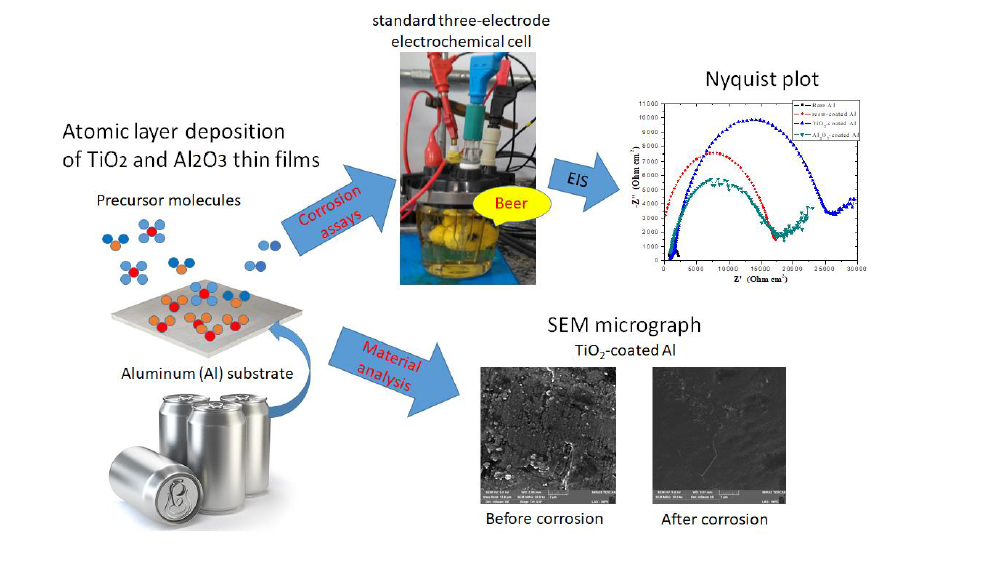You are currently viewing a beta version of our website. If you spot anything unusual, kindly let us know.
Preprint
Article
Atomic Layer Deposited TiO2 and Al2O3 Thin Films as Coatings for Aluminum Food Packaging Application
Altmetrics
Downloads
1083
Views
1021
Comments
0
A peer-reviewed article of this preprint also exists.
This version is not peer-reviewed
Abstract
Titanium dioxide (TiO2) and aluminum oxide (Al2O3) coatings have been investigated in a wide range of bio-applications due to their biodegradation and biocompatibility properties, that are key parameters for their use in the food packaging and biomedical devices fields. The present study evaluates and compares the electrochemical behavior of the non-coated, commercial resin-coated, TiO2-coated and Al2O3-coated aluminum in commercial beer electrolyte. For this, TiO2 and Al2O3 thin films were deposited on aluminum (Al) substrates using atomic layer deposition (ALD). The evaluation of the corrosion barrier layer properties was performed by linear sweep voltammetry (LSV) and electrochemical impedance spectroscopy (EIS). In addition, profilometry, grazing incidence X-ray diffractometry (GIXRD), scanning electron microscopy (SEM) and Fourier-transform infrared spectroscopy (FT-IR) analyses were performed to investigate the physical and chemical properties of the pristine and / or corroded samples. TiO2 and Al2O3 films presented an amorphous structure, a morphology that follows Al substrate surface, and a thickness of around 100 nm. Analysis of LSV data showed that ALD coatings promoted a considerable increase in corrosion barrier efficiency being 86.3% for TiO2-coated Al and 80% for Al2O3-coated Al in comparison with 7.1% of commercial resin-coated Al. This is mainly due to the lower electrochemical porosity, 11.4% for TiO2-coated Al and 20.4% for Al2O3-coated Al in comparison with 96% of the resin-coated Al, i.e. an increase of up to twofold in the protection of Al when coated with TiO2 compared to Al2O3 coated. The EIS results allow us to complement the discussions about the reduced corrosion barrier efficiency of the Al2O3 film for beer electrolyte once SEM and FT-IR analyzes did not show drastic changes in both investigated ALD films after the corrosion assays. The above results indicate that ALD TiO2 and Al2O3 films may be a viable alternative to replace the synthetic resin coatings frequently used in aluminum cans of use in the food industry.

Keywords:
Subject: Chemistry and Materials Science - Surfaces, Coatings and Films
Copyright: This open access article is published under a Creative Commons CC BY 4.0 license, which permit the free download, distribution, and reuse, provided that the author and preprint are cited in any reuse.
Submitted:
12 February 2019
Posted:
13 February 2019
Withdrawn:
Invalid date
You are already at the latest version
Alerts
A peer-reviewed article of this preprint also exists.
This version is not peer-reviewed
Submitted:
12 February 2019
Posted:
13 February 2019
Withdrawn:
Invalid date
You are already at the latest version
Alerts
Abstract
Titanium dioxide (TiO2) and aluminum oxide (Al2O3) coatings have been investigated in a wide range of bio-applications due to their biodegradation and biocompatibility properties, that are key parameters for their use in the food packaging and biomedical devices fields. The present study evaluates and compares the electrochemical behavior of the non-coated, commercial resin-coated, TiO2-coated and Al2O3-coated aluminum in commercial beer electrolyte. For this, TiO2 and Al2O3 thin films were deposited on aluminum (Al) substrates using atomic layer deposition (ALD). The evaluation of the corrosion barrier layer properties was performed by linear sweep voltammetry (LSV) and electrochemical impedance spectroscopy (EIS). In addition, profilometry, grazing incidence X-ray diffractometry (GIXRD), scanning electron microscopy (SEM) and Fourier-transform infrared spectroscopy (FT-IR) analyses were performed to investigate the physical and chemical properties of the pristine and / or corroded samples. TiO2 and Al2O3 films presented an amorphous structure, a morphology that follows Al substrate surface, and a thickness of around 100 nm. Analysis of LSV data showed that ALD coatings promoted a considerable increase in corrosion barrier efficiency being 86.3% for TiO2-coated Al and 80% for Al2O3-coated Al in comparison with 7.1% of commercial resin-coated Al. This is mainly due to the lower electrochemical porosity, 11.4% for TiO2-coated Al and 20.4% for Al2O3-coated Al in comparison with 96% of the resin-coated Al, i.e. an increase of up to twofold in the protection of Al when coated with TiO2 compared to Al2O3 coated. The EIS results allow us to complement the discussions about the reduced corrosion barrier efficiency of the Al2O3 film for beer electrolyte once SEM and FT-IR analyzes did not show drastic changes in both investigated ALD films after the corrosion assays. The above results indicate that ALD TiO2 and Al2O3 films may be a viable alternative to replace the synthetic resin coatings frequently used in aluminum cans of use in the food industry.

Keywords:
Subject: Chemistry and Materials Science - Surfaces, Coatings and Films
Copyright: This open access article is published under a Creative Commons CC BY 4.0 license, which permit the free download, distribution, and reuse, provided that the author and preprint are cited in any reuse.
Atomic Layer Deposited TiO2 and Al2O3 Thin Films as Coatings for Aluminum Food Packaging Application
Vanessa Dias
et al.
,
2019
Electro-Coloring Mechanism of Aluminum Anodic Oxides in Tin Based Electrolytes
Pinar Afsin
et al.
,
2024
Research on Nano-Titanium Modified Phenolic Resin Coating and Corrosion Resistance
Chengwu Zheng
et al.
,
2023
MDPI Initiatives
Important Links
© 2024 MDPI (Basel, Switzerland) unless otherwise stated











